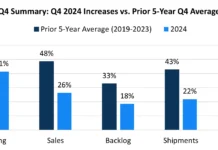By Lindsey Munson, editor, Plastics Business
With 2025 knocking at the door, the plastics industry is ready to turn the page by building on the momentum of the last year, maneuvering market demands, establishing relationships and strategically planning for the year ahead. There is cautious optimism among plastics processors, who likely will face challenges of economic fluctuations, regulatory shifts, supply chain pressures and geopolitical tensions, but with that comes opportunities for innovation, sustainable practices, technological advancements and market growth.
In working with three plastics professionals in the industry’s trenches, Plastics Business conducted a Q&A that gives context for what’s to come in 2025. These leaders share the challenges presently being faced and what’s expected in the new year, how to mitigate those challenges, their thoughts on the economic and political impacts, and lastly, what investments companies should have at the top of the list.
As companies plan for 2025, what challenges are expected in the plastics industry?
Mike Benson is the managing director in the Investment Banking Group at Stout, a global advisory firm specializing in corporate finance, accounting and transaction advisory, valuation, financial disputes, claims and investigations. Benson said, “As plastics processors look toward 2025, they face a landscape marked by uncertainty. The market conditions in 2023 and 2024 were challenging, with some sectors performing better than others, and overall optimism has waned. Interest rates recently have been lowered by half a point, a move that some interpret as a sign that the Federal Reserve is more concerned about the economy than publicly acknowledged. This shift has further dampened optimism, leading to a cautious approach among buyers and sellers in the M&A space.”
“The volume of new deals in 2024 was down by about a quarter to a third, reflecting this hesitancy. Private equity firms, in particular, have pent-up demand for selling holdings, including plastics companies, but confidence in market performance remains a critical factor,” he said.
“Thus, the key challenge for 2025 will be navigating this uncertainty and determining whether economic conditions will improve sufficiently to drive a resurgence in M&A activity,” said Benson.
Jim Bott, new business development manager with INCOE, a manufacturer of hot runner systems, took a deep dive into supply chain challenges, the economy and more. Bott said, ‟In the plastics industry, there is no crystal ball. For suppliers with manufacturing that takes place overseas, there is a possibility of higher costs due to tariffs on deliveries to US plastics processors. In addition, transportation costs likely are to increase. Another challenge is that sudden and unpredictable geopolitical risks exist – disrupting global trade routes and production sites that then lead to supply shortages, cost increases and delays. With that, when processors select suppliers, a ‘wild card’ should be factored in.”
“This year has been a challenge as processors have seen double-digit reductions in sales, compared to past years, and higher costs,” he continued. “2025 likely will have an increase in business opportunities than this year. The challenge is how suppliers react to the conditions they are experiencing this year, and the need to quickly respond and accommodate added potential business that will come in the next six months or less. Plastics processors are encouraged to visit and (re)evaluate existing and potential suppliers. As a processor, look at the supplier(s) used relative to past years and ask, ‘Have they retracted or invested in US, North America and/or global capabilities?’ to meet the company’s needs in the past three years and will through 2025. Since COVID-19, there has been a significant change regarding suppliers from known capacities and technologies to services whether in a positive or negative direction.”
“There is an old saying,” said Bott, “If it did not kill us, it made us stronger.”
Rich Dorans is president of PTA Plastics, Longmont, Colorado, a custom plastics injection molder specializing in high-precision and expertise. From 2024 through 2025, the challenges vary in scope and size, Dorans said: “Availability of labor has improved over the last six to nine months; however, the challenge is upskilling the workforce to meet the automation and technology needs of the future. Industry 4.0 has arrived, and processors need to utilize the tools available (AI, ML, digital transformation, etc.) to stay ahead of the competition and be a disrupter operationally rather than being disrupted.”
How do the current economic situation and upcoming presidential election impact this area?
Benson, Stout: “The current economic situation adds another layer of complexity for plastics processors as they plan for 2025. The recent interest rate cuts suggest that there may be underlying economic concerns that are not immediately apparent. Additionally, the upcoming presidential election introduces further unpredictability,” said Benson.
While the election itself may not directly influence decisions to buy or sell, Benson said, “The differing policies and geopolitical views of the candidates can impact economic outlooks and market conditions. For example, variations in tax policies and international trade stances could affect the performance of end markets that plastics processors rely on. This heightened uncertainty makes it difficult for companies to forecast accurately and plan strategically, complicating their outlook for the year ahead.”
Bott, INCOE: When asked this question, Bott immediately said, “Next question, please.” Then, he followed his statement up with, “On a serious note: Who recalls the index report in retraction (less than a score of 50) staying this way for so long? A few iconic businesses in the plastics industry have vanished in the last three years.”
Dorans, PTA Plastics: “Training is an investment for the future,” said Dorans “and the current economic climate and politics cannot prevent PTA Plastics from moving forward with its strategic plan.”
How can companies plan to mitigate those challenges? What investments are recommended in 2025?
Benson, Stout: To mitigate these challenges, Benson said, “Plastics processors should focus on cost management and maintaining a strong balance sheet. Companies that struggled in 2024 often did not make necessary cost cuts, hoping for a market turnaround that did not materialize. Therefore, it is crucial to right-size operations based on current revenue levels, even if it means reducing labor or renegotiating pricing with vendors and customers where they can.”
Continuing, Benson said, “For companies that already have streamlined their operations, maintaining lean operations and reducing debt can provide a competitive edge. A strong balance sheet helps companies weather economic uncertainty and positions them to seize new opportunities, whether through new business wins or strategic acquisitions.”
Bott, INCOE: With geopolitical tension, Bott said, “Plastics processors should, at a minimum, reevaluate and/or reconsider using suppliers with (all or majority) domestic manufacturing, engineering and service abilities. It is highly encouraged to visit suppliers, ask questions and visually see their productions for yourself.” In addition, Bott stated suppliers should demonstrate sustainability and longevity by spanning multiple markets, demonstrating employee satisfaction and having global capabilities when needed – which gives processors greater reach and opportunity to harness growth and increase the bottom line.
“The first recommendation is to invest in – or continue to invest in – the Manufacturers Association for Plastics Processors by engaging within the association, being more active,” said Bott, “and utilizing the membership to the fullest. It is through this organization, along with visiting other companies in the industry, that connections are made with ‘the best of the best’ processors and suppliers – creating a stronger foundation to build upon and deepening the strength of the plastics industry.”
“The second recommendation is to offer and schedule internal training. From first-hand experience, hot runner systems, temperature- and valve-gate-sequence controllers rely on proper training in start-up and shutdown procedures. Not knowing or following these steps can cost the processor significant costs and downtime, and not knowing proper service and maintenance can make a simple repair – unrepairable. Comprehensive usage procedures and maintenance training commonly are offered by suppliers free of charge. Training is a key component to success!” said Bott.
Dorans, PTA Plastics: “PTA Plastics has a 10-year strategic plan, which it just rebranded from PTA 2030 to ‘PTA 2035.’ It has a diverse group of 12 employee owners (PTA Plastics is an ESOP) who help transform how PTA operates today and in the future,” said Dorans. He shared PTA’s four focus areas and where it chooses to invest:
- Strategic intelligence (trends and markets)
- Digital transformation (molding and business processes)
- Upskilling (developing the talent for tomorrow)
- Growing the company
In conclusion, the plastics industry will see growth and transformation. The companies that open their doors and embrace the challenges and opportunities, while adapting to market conditions, will be optimally positioned to thrive through 2025.
More information: www.stout.com, www.incoe.com, www.ptaplastics.com





